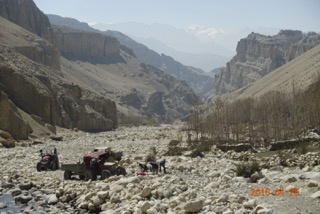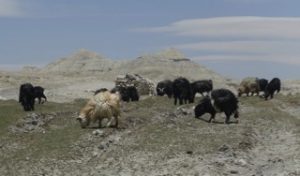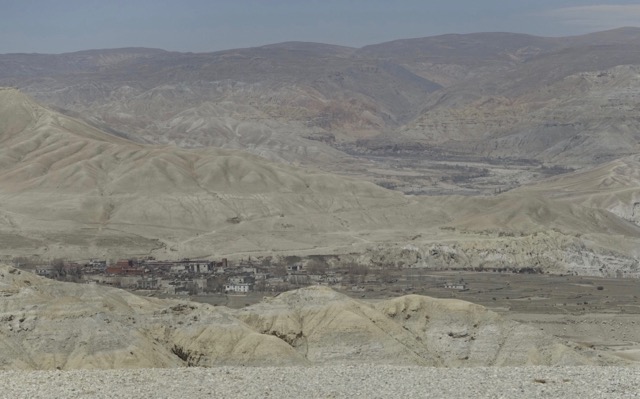Cheryl was having trouble getting one end of the prayer flags attached to the pole centered in the rock pile atop Lo La. The wind was as strong and persistent as we had yet seen. Chaim, no taller than Cheryl, nonetheless had the stability of one who’s summited Everest several times. While Pasang secured the far end to a large rock, Chaim looped the whipping flag rope over the top of the metal pole rising out of the concrete geo marker which formed the nexus of the pilgrim’s rock pile.
Lo La seemed the end of the world. We had been walking for four hours, and seen not one person or vehicle along the jeep track between Tsarang and Lo Manthang. Half way along the route, a giant lonely chorten stood athwart the road. Surrounded by a short chain link fence to protect against unlikely vandals, it seemed a sentinel marking the half way point between Mustang’s two largest settlements. We stopped for tea, which in this case meant sipping from the gatorade bottle and downing a few handfuls of my nut/chocolate/raisin mix.
Leaving Tsarang mid-morning, we had passed a similar, smaller chorten on the way out of town, standing guard over the town’s rock brigade, gathering that day’s quota of building stones from the river bed.  Then, nothing until the giant stupa. After the tea break, we kept walking through a landscape progressively more arid and devoid of life. As we crested a small defile, hoping we had reached the top, we entered a high rolling valley. To our right, the white sandy cliffside was pocked with caves scoured by the wind. In front, a small patch of green, seemingly filled with bushes which swayed a bit.
Then, nothing until the giant stupa. After the tea break, we kept walking through a landscape progressively more arid and devoid of life. As we crested a small defile, hoping we had reached the top, we entered a high rolling valley. To our right, the white sandy cliffside was pocked with caves scoured by the wind. In front, a small patch of green, seemingly filled with bushes which swayed a bit.
Drawing closer, the bushes materialized into … goats. Gnawing away at the patch of green, it was hard to see how they had gotten here, or even how they could survive, given that the grass they ate was only millimeters high, scraggly at best, and limited to a small football sized splotch which seemed merely moist, certainly not a true stream.
 Yet here they were, and in the midst of some ruined buildings, probably shepherds’ huts from sometime past. But they were a promise of the community ahead, harbingers of Lo Manthang.
Yet here they were, and in the midst of some ruined buildings, probably shepherds’ huts from sometime past. But they were a promise of the community ahead, harbingers of Lo Manthang.
Just one year ago, an earthquake had trembled through Nepal, with loss of life for some, and homes for others. Locally, there was little nostalgia for the event, but Cheryl was determined to hang a string of prayer flags at the highest point we reached that day, as her way of feeling communion with the people and their land.
I had a different set of feelings. I didn’t realise until I lifted my eyes from the flags, down into the vista spread below and beyond, that I had been seeking this moment for decades. I’d longed for a romanticized version of the Lost Horizon, a land and people cut off from the rest of us, where daily life was the only worry, lamas preached peace and respect for all sentient beings, and mountains ringed a verdant plateau, the Plain of Prayers. Over the past year, my dreams had crystallized around Lo Manthang, the walled city I could see below. I was on a pilgrimage, and my journey neared its end.
I found Cheryl at the top. I squeezed her close, pulled her to my side, and showed her Lo. “We’re here,” I said. “We made it.”
“Yes, we did.”


1 Response to This Magic Moment (Mustang VIII)